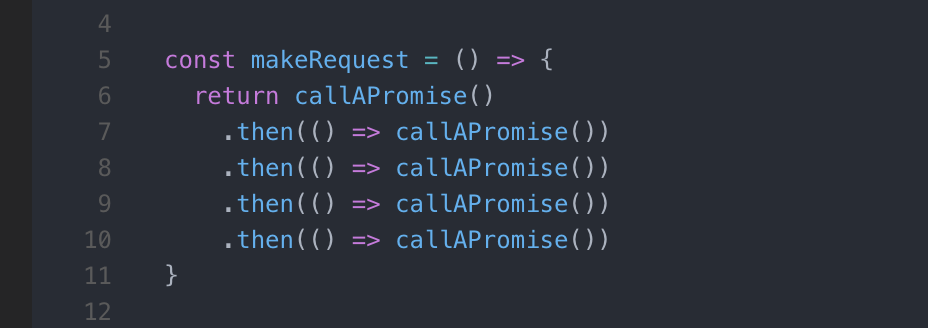Node.js 的异步编程方式有效提高了应用性能;然而回调地狱却让人望而生畏,Promise 让我们告别回调函数,写出更优雅的异步代码;在实践过程中,却发现 Promise 并不完美;技术进步是无止境的,这时,我们有了 Async/Await。
为了保证可读性,本文采用意译而非直译。
Node.js 7.6 已经支持 async/await 了,如果你还没有试过,这篇博客将告诉你为什么要用它。
Async/Await 简介
对于从未听说过 async/await 的朋友,下面是简介:
- async/await 是写异步代码的新方式,以前的方法有回调函数和Promise。
- async/await 是基于 Promise 实现的,它不能用于普通的回调函数。
- async/await 与 Promise 一样,是非阻塞的。
- async/await 使得异步代码看起来像同步代码,这正是它的魔力所在。
Async/Await 语法
示例中,getJSON 函数返回一个 promise,这个 promise 成功 resolve 时会返回一个 json 对象。我们只是调用这个函数,打印返回的 JSON 对象,然后返回”done”。
使用 Promise 是这样的:
const makeRequest = () =>
getJSON().then(data => {
console.log(data);
return"done";
});
makeRequest();
使用 Async/Await 是这样的:
const makeRequest = async () => {
console.log(await getJSON());
return"done";
};
makeRequest();
它们有一些细微不同:
函数前面多了一个 async 关键字。await 关键字只能用在 async 定义的函数内。async 函数会隐式地返回一个 promise,该 promise 的 reosolve 值就是函数 return 的值。(示例中 reosolve 值就是字符串”done”)
第 1 点暗示我们不能在最外层代码中使用 await,因为不在 async 函数内。
// 不能在最外层代码中使用await
await makeRequest();
// 这是会出事情的
makeRequest().then(result => {
// 代码
});
await getJSON()表示 console.log 会等到 getJSON 的 promise 成功 reosolve 之后再执行。
为什么 Async/Await 更好?
1. 简洁
由示例可知,使用 Async/Await 明显节约了不少代码。我们不需要写.then,不需要写匿名函数处理 Promise 的 resolve 值,也不需要定义多余的 data 变量,还避免了嵌套代码。这些小的优点会迅速累计起来,这在之后的代码示例中会更加明显。
2. 错误处理
Async/Await 让 try/catch 可以同时处理同步和异步错误。在下面的 promise 示例中,try/catch 不能处理 JSON.parse 的错误,因为它在 Promise 中。我们需要使用.catch,这样错误处理代码非常冗余。并且,在我们的实际生产代码会更加复杂。
const makeRequest = () => {
try {
getJSON().then(result => {
// JSON.parse可能会出错
const data = JSON.parse(result);
console.log(data);
});
// 取消注释,处理异步代码的错误
// .catch((err) => {
// console.log(err)
// })
} catch (err) {
console.log(err);
}
};
使用 async/await 的话,catch 能处理 JSON.parse 错误:
const makeRequest = async () => {
try {
// this parse may fail
const data = JSON.parse(await getJSON());
console.log(data);
} catch (err) {
console.log(err);
}
};
3. 条件语句
下面示例中,需要获取数据,然后根据返回数据决定是直接返回,还是继续获取更多的数据。
const makeRequest = () => {
return getJSON().then(data => {
if (data.needsAnotherRequest) {
return makeAnotherRequest(data).then(moreData => {
console.log(moreData);
return moreData;
});
} else {
console.log(data);
return data;
}
});
};
这些代码看着就头痛。嵌套(6 层),括号,return 语句很容易让人感到迷茫,而它们只是需要将最终结果传递到最外层的 Promise。
上面的代码使用 async/await 编写可以大大地提高可读性:
const makeRequest = async () => {
const data = await getJSON();
if (data.needsAnotherRequest) {
const moreData = await makeAnotherRequest(data);
console.log(moreData);
return moreData;
} else {
console.log(data);
return data;
}
};
4. 中间值
你很可能遇到过这样的场景,调用 promise1,使用 promise1 返回的结果去调用 promise2,然后使用两者的结果去调用 promise3。你的代码很可能是这样的:
const makeRequest = () => {
return promise1().then(value1 => {
return promise2(value1).then(value2 => {
return promise3(value1, value2);
});
});
};
如果 promise3 不需要 value1,可以很简单地将 promise 嵌套铺平。如果你忍受不了嵌套,你可以将 value 1 & 2 放进 Promise.all 来避免深层嵌套:
const makeRequest = () => {
return promise1()
.then(value1 => {
returnPromise.all([value1, promise2(value1)]);
})
.then(([value1, value2]) => {
return promise3(value1, value2);
});
};
这种方法为了可读性牺牲了语义。除了避免嵌套,并没有其他理由将 value1 和 value2 放在一个数组中。
使用 async/await 的话,代码会变得异常简单和直观。
const makeRequest = async () => {
const value1 = await promise1();
const value2 = await promise2(value1);
return promise3(value1, value2);
};
5. 错误栈
下面示例中调用了多个 Promise,假设 Promise 链中某个地方抛出了一个错误:
const makeRequest = () => {
return callAPromise()
.then(() => callAPromise())
.then(() => callAPromise())
.then(() => callAPromise())
.then(() => callAPromise())
.then(() => {
thrownewError("oops");
});
};
makeRequest().catch(err => {
console.log(err);
// output
// Error: oops at callAPromise.then.then.then.then.then (index.js:8:13)
});
Promise 链中返回的错误栈没有给出错误发生位置的线索。更糟糕的是,它会误导我们;错误栈中唯一的函数名为 callAPromise,然而它和错误没有关系。(文件名和行号还是有用的)。
然而,async/await 中的错误栈会指向错误所在的函数:
const makeRequest = async () => {
await callAPromise();
await callAPromise();
await callAPromise();
await callAPromise();
await callAPromise();
thrownewError("oops");
};
makeRequest().catch(err => {
console.log(err);
// output
// Error: oops at makeRequest (index.js:7:9)
});
在开发环境中,这一点优势并不大。但是,当你分析生产环境的错误日志时,它将非常有用。这时,知道错误发生在 makeRequest 比知道错误发生在 then 链中要好。
6. 调试
最后一点,也是非常重要的一点在于,async/await 能够使得代码调试更简单。2 个理由使得调试 Promise 变得非常痛苦:
- 不能在返回表达式的箭头函数中设置断点
- 如果你在.then 代码块中设置断点,使用 Step Over 快捷键,调试器不会跳到下一个.then,因为它只会跳过异步代码。
使用 await/async 时,你不再需要那么多箭头函数,这样你就可以像调试同步代码一样跳过 await 语句。
结论
Async/Await 是近年来 JavaScript 添加的最革命性的特性之一。它会让你发现 Promise 的语法有多糟糕,而且提供了一个直观的替代方法。
忧虑
对于 Async/Await,也许你有一些合理的怀疑:
- 它使得异步代码不再明显: 我们已经习惯了用回调函数或者.then 来识别异步代码,我们可能需要花数个星期去习惯新的标志。但是,C#拥有这个特性已经很多年了,熟悉它的朋友应该知道暂时的稍微不方便是值得的。
- Node 7 不是 LTS(长期支持版本): 但是,Node 8 下个月就会发布,将代码迁移到新版本会非常简单。(Fundebug 注:Node 8 是 LTS,已经于 2017 年 10 月正式发布。)


